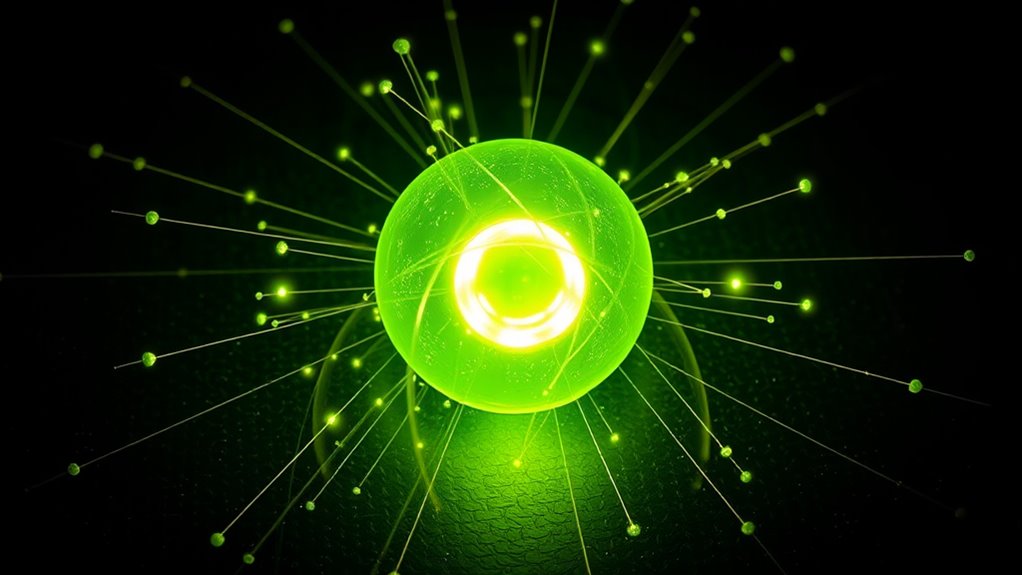Radioactivity is the process where unstable nuclei emit particles or energy, transforming into more stable forms. This includes alpha, beta, and gamma emissions, each with different penetration levels. You can understand it through half-lives, which tell you how long a material takes to decay by half. Naturally occurring elements like uranium and potassium constantly decay, producing heat and shaping our planet. Keep exploring to learn more about how nuclear decay impacts science, medicine, and our world.
Key Takeaways
- Radioactivity involves unstable nuclei emitting particles or energy to become more stable through natural or artificial decay.
- Types of emissions include alpha particles, beta particles, gamma rays, and neutrons, each with different penetration abilities.
- Nuclear decay follows statistical patterns characterized by half-lives, indicating how long it takes for half of a sample to decay.
- Radioactive elements are naturally present on Earth, contributing to geological processes and Earth’s internal heat.
- Detection methods like Geiger counters and scintillation detectors measure radiation to monitor safety and research applications.
What Is Radioactive Decay?

Radioactive decay is the process by which an unstable atomic nucleus loses energy by emitting radiation. When this happens, the nucleus transforms into one or more different nuclei, called daughter nuclei, which are more stable and lower in energy. This process occurs spontaneously and naturally in certain elements, making it a fundamental aspect of nuclear chemistry. This spontaneous change occurs naturally in certain elements and can also be induced artificially. The process is random at the atomic level, so you can’t predict exactly when a specific atom will decay. However, on a larger scale, the decay rate follows a statistical pattern described by a decay constant or half-life. During decay, the nucleus undergoes nuclear transmutation, changing the number of protons and forming a new element. This process helps explain why some elements are radioactive and how they pass toward stability over time, driven by nuclear stability principles.
Types of Radioactive Emissions

When an unstable atom undergoes decay, it releases energy in various forms known as radioactive emissions. You’ll encounter alpha particles, which are heavy and positively charged, consisting of two protons and two neutrons. They don’t penetrate much and can be stopped by paper or skin. Alpha particles are capable of causing significant damage inside the human body if ingested or inhaled because they lose all their energy in a small volume, making internal exposure particularly hazardous. Beta particles are high-energy electrons or positrons; beta-minus produce electrons inside the nucleus, while positrons annihilate upon contact with electrons. They’ve moderate penetration, stopped by plastic or thin metal. Gamma rays are electromagnetic waves with high energy and no charge, making them highly penetrating—they can pass through the human body and thick materials like lead. Neutron emissions are neutral and deeply penetrating, playing an essential role in nuclear reactions. Neutron emissions are particularly relevant in nuclear reactors and weapons, where they sustain chain reactions. Other emissions include fission fragments, protons, gamma rays from isomeric transitions, and sometimes X-rays, broadening the range of radioactive decay products.
How Do Half-Lives Work?
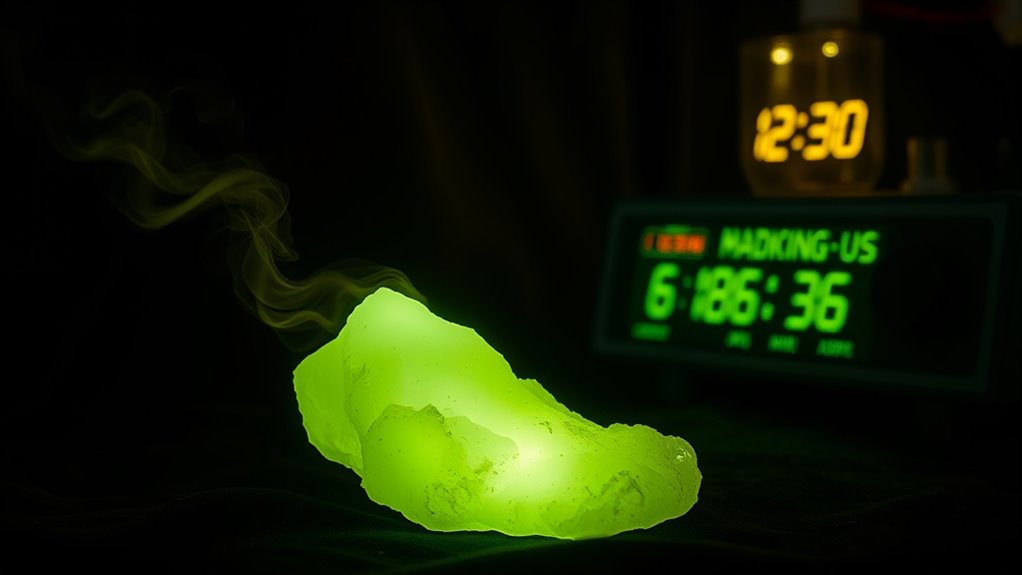
Half-life is the time it takes for half of a radioactive substance to decay. During this period, unstable atoms lose half of their nuclei through radioactive decay, following an exponential pattern. Understanding cookie types can help clarify how websites track and analyze user behavior. This means that after one half-life, only 50% of the original atoms remain; after two, 25%; after three, 12.5%, and so on. The process is random for each nucleus but predictable statistically. The half-life is a fixed property of each isotope, unaffected by sample size, temperature, or pressure. It’s related to the decay constant by the formula ( t_{1/2} = frac{ln 2}{lambda} ). Understanding this helps you estimate how long a radioactive material remains active and predict its decay over time accurately.
The Process of Nuclear Transmutation
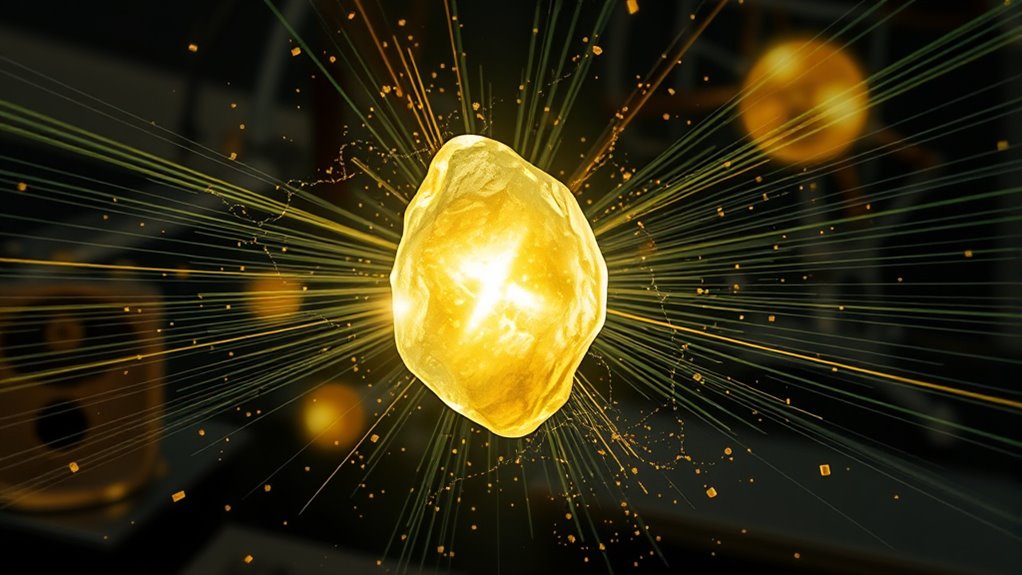
Nuclear transmutation involves changing an atom’s nucleus to alter its identity by adjusting the number of protons or neutrons. You can achieve this through nuclear reactions or spontaneous radioactive decay, such as alpha or beta decay. Heat pumps can be used in some nuclear facilities to improve energy efficiency and temperature control during operations.
Transmutation is used to transform base metals into precious ones or create synthetic elements. Natural transmutation occurs in stars and supernovae, forming heavier elements via fusion and explosive processes.
Transmutation creates synthetic elements and transforms base metals into precious ones naturally and artificially.
Artificial transmutation requires physical means like particle accelerators, which use electromagnetic fields to accelerate particles and induce nuclear reactions. Neutron capture also plays a role, especially in reactors.
This process demands significant energy and poses technological challenges. Understanding transmutation helps explain how elements are formed naturally and how we manipulate nuclei intentionally for energy, medical, and industrial applications.
Naturally Occurring Radioactive Elements on Earth
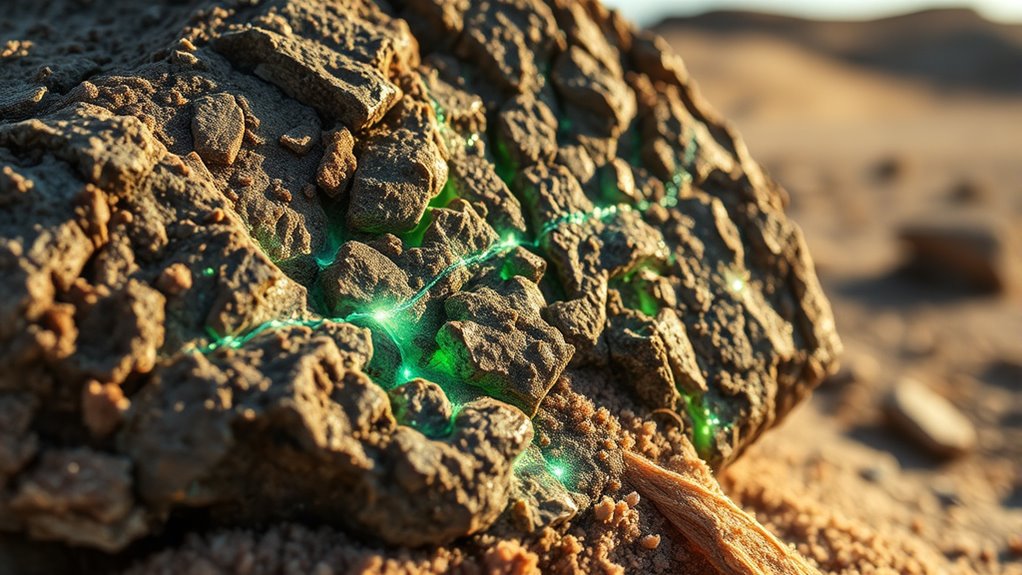
The Earth’s crust naturally contains several radioactive elements, with uranium and thorium being the most prominent. These elements decay slowly over billions of years, producing decay products like radium and radon gas.
Potassium-40, a common isotope of potassium, also contributes to natural radioactivity, with a half-life of about 1.25 billion years. While concentrations of uranium, thorium, and potassium-40 vary by location, they generally exist in low amounts across the crust.
Radon gas, a decay product of uranium and thorium, can accumulate in enclosed spaces and pose health risks. These elements are found in minerals, ore deposits, and even in everyday foods due to potassium’s abundance.
Human activities, like mining, can concentrate these materials, leading to increased exposure and the formation of Technologically Enhanced Naturally Occurring Radioactive Materials (TENORM).
Decay Chains and Radioisotope Series
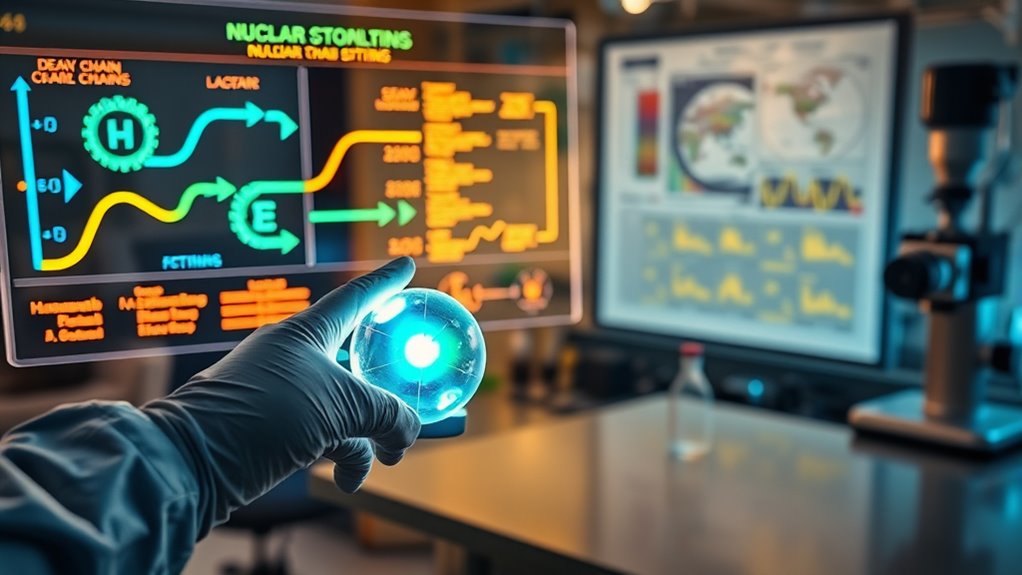
Decay chains describe the series of steps that unstable isotopes go through as they transform into stable nuclei. You’ll see each radioactive isotope decay into a daughter isotope, which may itself be radioactive, creating multiple decay steps. These chains continue until a stable isotope forms, usually a noble gas or a lead isotope. The members of decay chains have varying half-lives, from seconds to millions of years, influencing radiation emission. These chains are vital for understanding natural radioactivity, environmental impacts, and radiometric dating, all rooted in the predictable sequence of decay processes. The contrast ratio of the involved isotopes affects the visibility and detection of emitted radiation over time.
Applications of Radioactivity in Science and Medicine

Have you ever wondered how radioactivity transforms medicine and science? It plays a crucial role in diagnosing and treating illnesses.
In medicine, radiation therapy targets cancer cells while sparing healthy tissue. Radioactive tracers in PET and SPECT scans reveal organ functions and detect abnormalities. Radioactive iodine treats thyroid issues, and radionuclides combined with monoclonal antibodies target leukemia cells. Bone and liver scans identify cancer spread.
In research, radionuclides help study genetics, environmental pollution, and archaeological dating with Carbon-14. They also assist in analyzing materials and improving agriculture.
Diagnostic procedures like PET, SPECT, and nuclear cardiology provide detailed images of tissues and organs. These applications make radioactivity indispensable in advancing medical and scientific knowledge, saving lives, and improving health outcomes.
Safety and Risks of Radioactive Materials
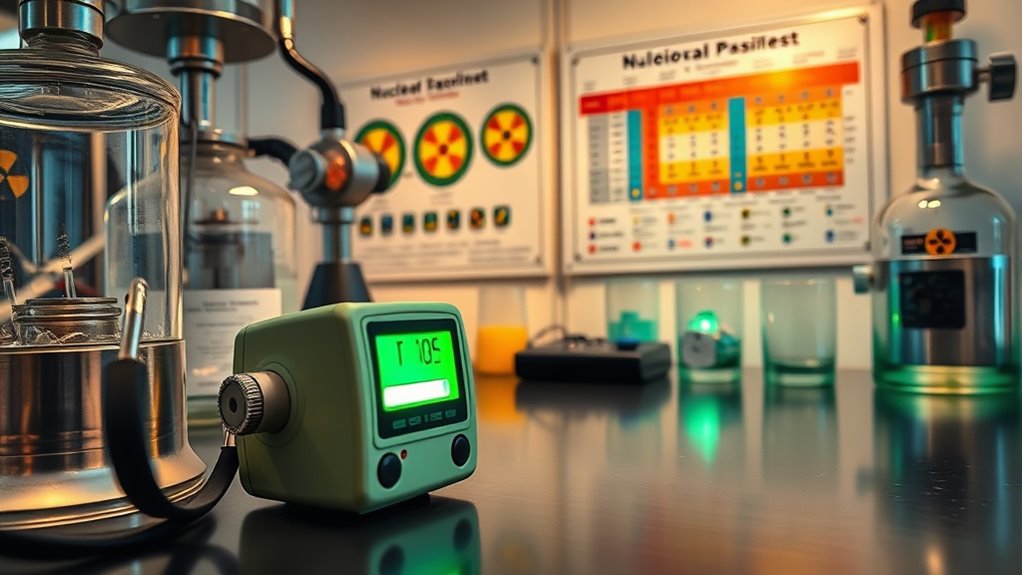
Ever wonder what risks come with handling radioactive materials? You need to understand that ionizing radiation can damage your body tissues chemically, leading to skin burns, hair loss, internal bleeding, anemia, and immune system suppression. Kitchen materials and safety protocols are essential in managing these risks effectively. High doses considerably increase your lifetime cancer risk by damaging DNA. In extreme cases, you could experience acute radiation syndrome, impacting multiple organs. Localized exposure may cause severe skin injuries. Pregnant individuals face additional risks, like developmental defects or miscarriage, so they require special precautions. Accidental exposure can happen due to equipment failure, human error, or spills, risking contamination and injury. Proper training, safety protocols, containment measures, PPE, and regular maintenance are essential to minimize these dangers. Preparedness plans and continuous health monitoring help manage long-term risks effectively.
Measuring and Detecting Radioactive Decay
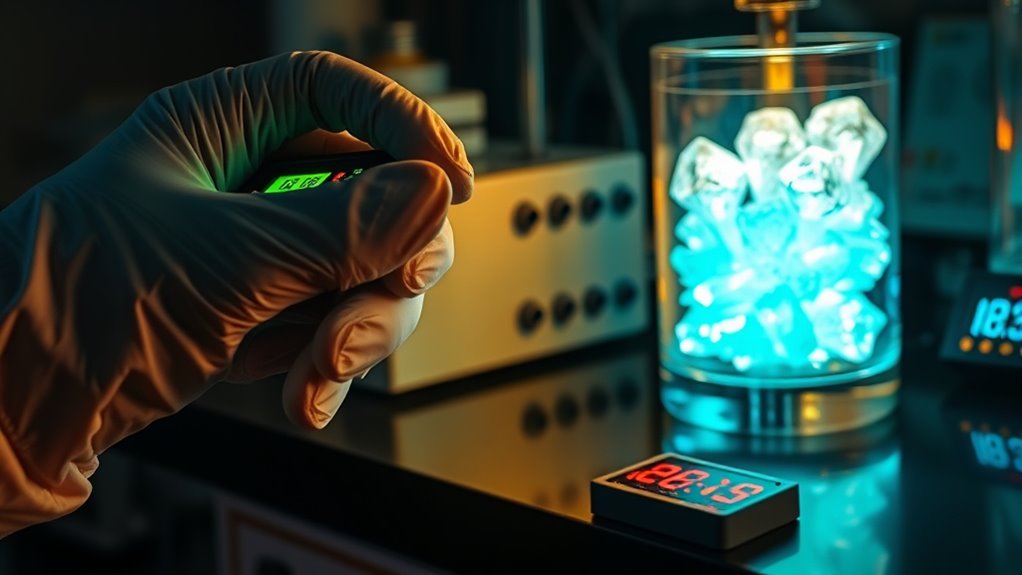
Measuring and detecting radioactive decay involves using specialized instruments to identify and quantify radioactive emissions. You’ll encounter devices like Geiger counters, which detect ionization caused by radiation, providing counts per minute to measure activity.
Scintillation detectors convert radiation into visible light, while spectrometers identify energy levels and types of radiation. Dosimeters and film badges measure radiation exposure, especially for personnel safety.
Detection depends on the radiation type—alpha, beta, or gamma—and calibration is essential for accurate readings. Radioactivity is expressed in units like becquerels (Bq) and curies (Ci), indicating decay rates.
These tools help you monitor and assess radioactive materials effectively, whether for research, safety, or medical purposes. Accurate detection ensures you comprehend the presence and level of radioactivity in various environments. Cybersecurity vulnerabilities can also impact the safety and integrity of measurement devices, emphasizing the importance of secure systems in radiation detection.
The Role of Radioactivity in Understanding Our Planet

Did you know that radioactivity plays an essential role in shaping Earth’s internal processes? The decay of isotopes like potassium, uranium, and thorium generates significant heat in the Earth’s interior. This heat drives plate tectonics, mountain formation, and volcanic eruptions. Heat generation also causes groundwater circulation, forming hydrothermal systems rich in minerals. Radioactive heat influences regional geothermal activity, affecting climate patterns indirectly.
By contributing to the planet’s heat budget, radioactivity supports geological activity over billions of years. It impacts the movement of tectonic plates, leading to earthquakes and the creation of new landforms.
Understanding these processes helps us grasp Earth’s dynamic nature and its continuous evolution. Radioactivity therefore provides critical insight into the planet’s inner workings and geological history.
Frequently Asked Questions
How Is the Decay Constant Mathematically Related to Half-Life?
You want to know how the decay constant relates mathematically to half-life. The relationship is straightforward: the decay constant ((lambda)) equals 0.693 divided by the half-life ((T_{1/2})).
In other words, (lambda = ln(2)/T_{1/2}).
This means a shorter half-life results in a larger decay constant, indicating faster decay, while a longer half-life means a smaller decay constant and slower decay.
Can Radioactive Decay Be Accelerated or Influenced by External Factors?
You might wonder if external factors can speed up radioactive decay. Generally, they can’t, because decay is a nuclear process driven by instability, not environmental conditions.
Minor effects, like changes in electron surroundings, can slightly alter decay rates, but only by less than 1%. Extreme laboratory conditions have shown some acceleration, yet these aren’t natural or practical.
What Determines Whether a Nucleus Undergoes Alpha or Beta Decay?
Think of a nucleus as a balanced scale. If it’s too heavy or unstable, it tips toward decay.
You determine whether it undergoes alpha or beta decay mainly by its neutron-to-proton ratio. When there are too many neutrons, it favors beta decay to balance out.
If it has too many protons, alpha decay might occur to shed excess mass.
The nuclear binding energy and stability also influence the decay choice.
How Do Decay Chains Impact the Long-Term Stability of Radioactive Elements?
Decay chains directly influence the long-term stability of radioactive elements by guiding their transformation into stable atoms through multiple decay steps.
As you follow the chain, the unstable isotopes emit radiation and change into different elements until reaching a stable nuclide.
This process can take a long time, especially with complex chains, meaning radioactive materials remain hazardous for extended periods.
Understanding these chains helps you predict how long radioactivity persists and manage associated risks.
Are All Radioactive Isotopes Naturally Occurring or Artificially Created?
You might think all radioactive isotopes are either naturally occurring or artificially made, but the truth is a bit of both. Natural isotopes like uranium and potassium have existed since Earth’s formation.
While humans create others in reactors or cyclotrons for medicine and industry. So, it’s a case of the best of both worlds—some isotopes are born in nature, others are crafted by us to serve specific needs.
Conclusion
Now that you understand the fundamentals of radioactive decay and its many applications, you might wonder how much we still have to learn. Radioactivity shapes our world—from medicine to geology—and continues to fascinate scientists. As you explore its mysteries, ask yourself: how can harnessing nuclear decay improve our future? Embracing this knowledge helps us navigate the risks and benefits of nuclear science—ultimately empowering you to make informed decisions about its role in our lives.
